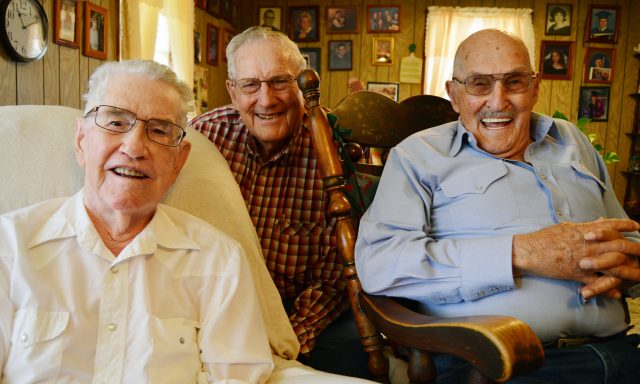
By John Balch
Leader staff
UMPIRE – Two of them are cousins, the other a brother-in-law. All three raised in northern Howard County. There are 286 years between them and all three are World War II veterans. Their experiences fighting the war couldn’t have been more different.
Lloyd Kesterson, 92, is the youngest of the bunch. He fought in Europe against the Germans and the winter cold during the Battle of the Bulge as part of the 70th Infantry Division’s Company I 274th Infantry.
Jessie Simmons is 94 and trucked his way across the war’s Mediterranean Theater with the 57th Quartermasters Corps as the Allies participated in one of the war’s longest campaigns.
Marvin Hill, 100, and Simmons are first-cousins. Hill and Kesterson’s sister had already started a family when the 841st Aviation Engineers C. Company entered the war’s Pacific Theater to aid the fight against the Japanese.
Hill was 28 when the war called; the other two were barely in their 20s. Hill could now pass for a 70-year-old and has a boastfulness that is served with a big smile and laugh.
“When I hit basic training there was 21s to 23s, I could go around them all. I’m not bragging, you know,” Hill cracked as he sat alongside Kesterson in Simmons’ home.
“I told them, ‘This is the best vacation I’ve ever had.’”
Indeed, as all three men were born during or on the heels of the Great War and their families had labored through the Great Depression. Simmons recalled being just seven years old and hand-cutting cross-ties all day with his 11-year-old brother. Or the times he worked the fields all day for 75 cents and lunch. “That was big as a wagon wheel back then,” he said.
“That was just our generation,” Simmons added, “hard-working.”
Simmons was the first to ship out, Oct. 1, 1942, and he served the longest of the three. He rolled nonstop from the time his boots hit the ground in North Africa.
“I was in the combat zone for 30 months and nine days, and I drove a truck the whole way through,” he said. “I hauled everything from deceased people to whatever was needed on the frontline.”
The Allies had pushed the German forces out of North Africa and were moving toward Italy. “Ever time they made a push, we made a push,” Simmons said about the constant trucking to the places he never dreamed about – or didn’t even know about.
But when the troops crossed the Straits of Gibraltar into Spain, Simmons recalled a teacher he and Kesterson had back at the Umpire school, Bessie Strasner.
“Back in school I was such a dumb-head, I didn’t care whether I ever learned about geography,” Simmons said with a chuckle. “And here I was, crossing the Straits of Gibraltar just like Miss Bessie tried to teach us about way back when.”
The back-and-forth trips between supply points and the front were frequent, as Simmons’ unit and other support divisions tailed the infantry. German air raids and surveillance flights forced Simmons’ transport convoy to mostly travel at night in blackout conditions. Simmons clearly remembers the only light being the two tiny red brake lights of the truck ahead and his steel helmet rattling on his head as he bumped along.
“You didn’t use your headlights, they’d get you before you got started,” he said.
When Simmons said he hauled everything to and from the front, he means it.
His unit once transported 25 loads of big pack mules to the front to be used in the mountains. Another time he returned to the rear echelon with a load of prisoners of war.
“They were glad to get caught,” Simmons said. “You didn’t have to worry about them, they were happy to just get out of there.”
Simmons’ unit was also involved in the clean-up when the war ended and backtracked through Italy. He would haul the Allies’ equipment to the ports where it was packed on boats, taken out to sea and dumped.
“We couldn’t take all that stuff back with us, so that’s where it went,” Simmons said.
After dropping the mules, Simmons’ lieutenant determined the return trip was too risky at the time and the trucks were parked under olive trees to avoid the German’s aerial surveillance. It was from vantage points such as this one that Simmons said he witnessed the war.
His memories are vivid of tracer bullets lighting up the night sky like fireworks, German aircraft being shot down, bunkers being blown away and towns reduced to rubble. The fighting was fierce, the work was hard and the body count was high.
“You can’t imagine some of the things I saw,” Simmons said.
Simmons never received a scratch during the war and his truck never once broke down. He said he was unaware of the passage of time during those 30 months and nine days.
“We were just too busy all the time to worry about that,” he said. “You just worried about staying alive.”
Kesterson was the only one of the three who was somewhat injured in the war. But it wasn’t a German that got him, it was the cold.
The Battle of the Bulge was the Germans’ last major offensive and was an attempt to surprise and separate the Allied forces with a winter push through the cold Ardennes Mountains to Antwerp, Belgium. The battle involved 250,000 German soldiers and was the biggest and deadliest campaign ever fought by the U.S. Army. Tens of thousands American soldiers were hurt or killed in the battle but their efforts depleted the German’s resources and set the stage for the end of the European war.
“You had to dig a new foxhole every night,” Kesterson said. “Squat down in it for the night, and get up the next morning and do it all over again. We had to gain a distance every day.”
It was cold and muddy, and when it wasn’t snowing it was sleeting or storming. During the entire battle in the wilds of the snow-capped mountain and thick forest, Kesterson said he never saw a building of any type. The soldiers lived foxhole to foxhole and ate “frontline rations.”
The sound of bullets whizzing by and incoming artillery fire were constant on the frontline. Today, Kesterson seems in disbelief that he could have ever gotten used to those types of surroundings. “You just kindly get used to it, I guess,” he said. “It was a daily deal for us.”
Failing to get settled in before nightfall, stepping out of line or grouping up during daylight could be deadly. “The enemy was out there and could spot you just as easy as you could them,” Kesterson said.
Kesterson’s unit was foot soldiers, rarely catching rides across the rugged cold and wet terrain. Many of the soldiers were affected by the weather and conditions, and after several months on the mountain, Kesterson’s feet literally froze.
“It was snowy and wet and you wore your shoes day and night,” he said. “It didn’t hurt. There was no feeling at all. They were frozen.”
When Kesterson eventually reached a field hospital, he was told his feet were “right up to the amputating point.”
“A buddy lost his, a lot did,” he said.
It took three days and nights to thaw his feet out and the doctor warned Kesterson he would have problems in his old age. Just three years ago, the doctor’s warning came true. “I was fortunate to keep them because I used them all those years,” Kesterson said with a quiet smile.
Kesterson’s injury did not keep him from returning to his unit.
Soon after his feet thawed, a push was made to cross the Ruhr River, a tributary of the Rhine River in western Germany. The Allied troops were trying to clear the way for advancing troops by bombing the enemy positions on the opposite banks day and night.
Kesterson had watched this play out for several days when the first attempts by boats were made. The first and second attempts were unsuccessful and resulted in many injuries and deaths. “They just unloaded on them,” he said.
Kesterson was part of the third wave and when his boat neared the opposite bank he bailed out – cold feet and all – into the cold water and clambered for the banks.
A few days later, Kesterson heard that Gen. George Patton, also known as “Old Blood and Guts,” had crossed the river at the same spot but aided by pontoon bridges.
Like his cousin, Kesterson had dealings with German prisoners of war who were cold, battle-weary, and grateful to be taken into custody by the American troops. As his unit marched toward Berlin, Kesterson said five unarmed German soldiers suddenly popped up out of the trenches to surrender.
“I wasn’t afraid of them, it was the others ones that were in there,” he said about the POWs. In fact, Kesterson, as ordered, marched the prisoners back to the rear guard for transport by himself. They all ducked enemy shelling together but Kesterson wasn’t concerned.
“Of course, I had a gun and they didn’t,” he added.
Kesterson’s unit was well on the way to Berlin when the Soviets forced the Germans into surrender and the European war came to a close. Plans almost shifted Kesterson to Japan, the same place his brother-in-law was headed.
Hill’s stint with the 841st Aviation Engineers started in 1943. The island-hopping operatives of the Pacific Theater carried the young husband and father to New Guinea, Dutch East Indies and the Philippines, among others. “I went to so many places I can’t recall them all,” Hill said.
An Allied counterattack against the Japanese was well underway and the engineering unit was tasked with building the airfields needed to advance the lead of Gen. Douglas MacArthur, who Hill saw from time to time when a headquarters was established in New Guinea. Hill referred to him as “old Doug” and “a real G.I.”
The plan was to eventually invade the Japanese homeland.
“We’d build the airfields, and night after night they’d bomb it,” Hill said about the Japanese air strikes. He said he will never forget the sound of the incoming rounds.
“You can hear a bomb coming, whistling,” he said. “It just gets louder and it screams right before it hits the ground.”
Hill also said he would never forget the sound of Tokyo Rose, the generic name given to female radio broadcasters of Japanese propaganda. “Man, she had a golden voice that could soothe a baby, put a man to sleep.”
Every night the radar would show the blips on the screen heading in for another pass. The Japanese were also using what American soldiers called “daisy cutters,” a fuse device designed to detonate the bomb before it buries in the ground. Hitting the foxholes and racing for the trenches, which were dug in different directions for different approaches, was a common occurrence.
“You ever hear a bullet sing The Graveyard Blues?” Hill said with a sly grin and laugh.
Hill loves to tell tales and laugh, but his eyes narrow when he recalls missing his family, enduring the muggy 120-degree heat, the threat of malaria and watching the island natives “digging graves day and night.”
“We came up on a cemetery one time and the white crosses were lined up any which way you looked,” he said.
Hill’s mind was always on his wife and daughter, especially as night approached.
“We had to be where we were going before dark,” he said. “And I always looked at my pictures right before dark – you might wake up dead the next morning.”
Hill said he feared for his life many times. It sometimes went beyond being scared. His older brother, Shorty, fought in Europe and he once told his brother he wasn’t scared, he was frightened. “There’s a difference, you know,” he said.
Hill’s unit had advanced to Manila, Philippines, when the Japanese’s refusal to surrender resulted in the U.S. dropping the atomic bomb – first on the Japanese city of Hiroshima and then Nagasaki. The bombings would kill an estimated 120,000 and injured thousands. Many thousands more would die from the radiation fallout.
At the time, Hill didn’t have enough points to be discharged and his unit was prepared to continue to Japan when the bombs were dropped.
“It was awful, it really was, but it saved my life. It saved many a life,” Hill said about the U.S. decision to deploy nuclear warfare for the first and only time.
Hill was not hurt during his deployment. But, “I lost my marbles,” Hill said, drawing laughs from Simmons and Kesterson. He laughs, too, but he is serious. He saw it many times, soldiers wandering around in the sweltering heat like they were looking for something.
“They’re looking for their marbles and the boys that never found them are still that way,” he said.
Hill then defuses the serious tone: “I found some of mine, but I think they are the wrong ones.”
Kesterson, Simmons and Hill may not be able to recall every thing or every place and date involved in their war experiences, but they all remember when they landed back in the States. Simmons and Hill can remember the exact date, Nov. 22, 1945 and Dec. 18, 1945, respectively. Kesterson can recall the feeling of relief, but not the exact date when his boots returned to American soil.
“He’s getting old,” said the 100-year-old Hill to a chorus of laughter.







